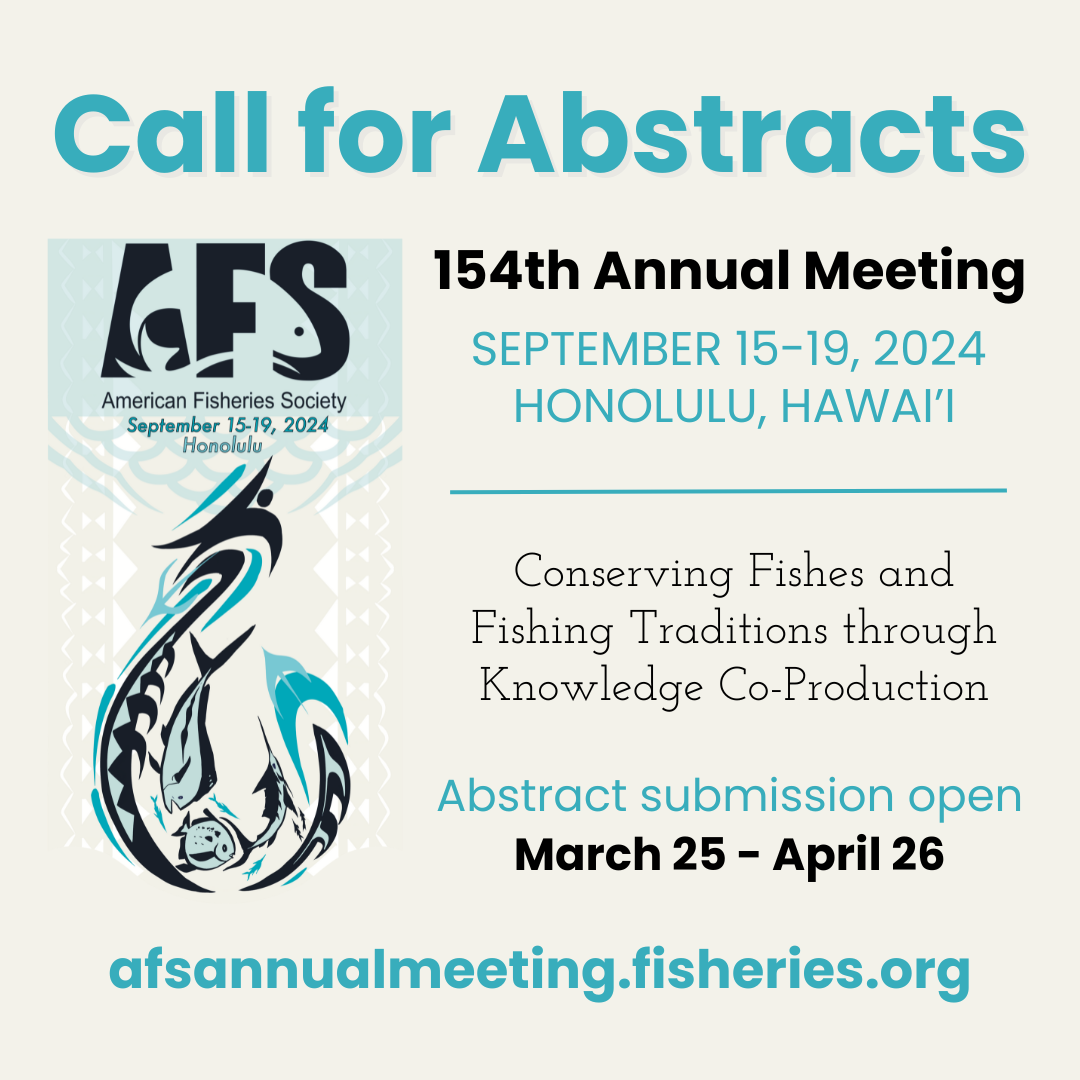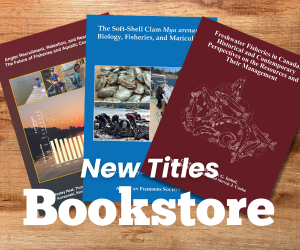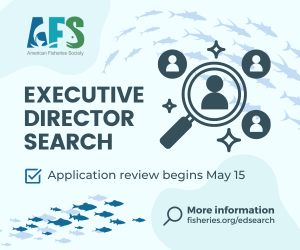D. Derek Aday, Daniel J. Daugherty, Debra J. Murie
In 2017, the American Fisheries Society (AFS) conducted a publications survey and convened a special committee in Reno, Nevada, (hereafter referred to as the “Reno meeting”) to discuss survey results and develop strategies to enhance the success and value of the AFS publications program. The meeting focused on developing specific strategies to maximize the effectiveness and attractiveness of AFS journals, determine how to effectively use journal rankings and citation‐based impact factors, provide clearer aims and scope for all AFS journals and avoid “mission creep” among them, and develop a plan for resolving journal‐associated (and, in some cases, journal‐specific) problems and concerns.
One outcome of that meeting was the creation of editor‐in‐chief (EIC) positions for four of the AFS journals: Transactions of the American Fisheries Society (TAFS, Aday), the North American Journal of Fisheries Management (NAJFM, Daugherty), Marine and Coastal Fisheries: Dynamics, Management, and Ecosystem Science (MCF, Murie), and Fisheries, Jeff Schaeffer). Previously, the editorial boards for these journals were led by multiple co‐editors; the EIC positions were created to provide greater oversight, accountability, and mentorship; improve efficiency, consistency, and direction; and liaise with authors, readers, and associated AFS sections. As the newly appointed EICs, we wish to communicate the primary recommendations of the Reno meeting, focusing on both the programmatic and journal‐specific strategies that our journals are actively working to implement.
PROGRAMMATIC RECOMMENDATIONS
AFS journals are central to the Society, with a long history of success and a well‐established foundation on which to build new strategies to ensure that AFS is meeting the needs of fisheries and aquatic science professionals around the world. Collectively, the AFS journal suite touches nearly every aspect of research and management in freshwater and marine ecosystems, positioning the AFS journals to be global leaders in the aquatic scientific community.
Although many of the survey outcomes and corresponding recommendations from the Reno meeting were specific to individual journals, some were transcendent. Most notable of these was a need to improve the consistency and quality of the peer review process. As previously noted, the EICs are charged with providing greater oversight of and mentorship within the editorial boards, which constitutes one means of improving the process. A second means is providing greater guidance to peer reviewers, facilitating more focused, concise, and comparable reviews. To that end, a new peer reviewer interface has been developed and is currently being tested in NAJFM. Following testing and revision, it will be available for adoption by the remaining AFS journals. A third means is better matching manuscript assignments to associate/subject editor expertise—an ongoing challenge given the expanding scope and breadth of several of our journals. To meet those needs, an effort is under way to expand the editorial boards where necessary. Additional approaches to improving the quality and timeliness of the peer review process involve recruiting new, qualified reviewers and providing greater incentives for contributing peer reviews. Multiple approaches are being considered, including requesting that each submitting author commit to serving as a peer reviewer for another submission, the creation of an editorial award program, and the development of a recurrent continuing education course on peer review. Our new publisher, Wiley, also participates in Publons—a free Web service that tracks, verifies, and credits the editorial contributions of reviewers while maintaining their anonymity—which might encourage some fisheries professionals to undertake more reviews.
Time to publication was also noted as an area for improvement based on the survey responses. Comparison of the statistics for AFS journals with those for other fisheries journals indicates that our times to publication are consistent with industry averages. However, many of the programmatic changes discussed previously will likely improve these times. Additionally, recent adoption of the early online access option greatly advances the time at which accepted manuscripts are available to readers. To some extent, substantially reducing publication times will require a culture change within the AFS journals community, including a greater commitment among AFS members and authors to providing meaningful and timely reviews on a regular basis; stricter enforcement of the time limits on reviewers by editors and associate editors; and regular communication among the EICs, editorial boards, the AFS Publications Overview Committee, AFS journals staff and the publisher to evaluate and, as necessary, modify publication procedures to ensure an effective and efficient process.
JOURNAL‐SPECIFIC RECOMMENDATIONS
Transactions of the American Fisheries Society
Transactions of the American Fisheries Society is the oldest and most widely recognized AFS journal, focused on publishing the best scientific content with the broadest disciplinary scope in the AFS portfolio. Broadly speaking—and in keeping with a Society that is similarly growing beyond the boundaries implied by its name—TAFS is intended for fisheries and aquatic science professionals around the world. Although TAFS is generally recognized as the flagship scientific journal of the Society, work remains to be done to improve its reputation among the global fisheries science community. The specific goals established by the TAFS subcommittee of the Reno meeting were to increase the journal’s impact factor (and associated citation metrics) and decrease the time to publication of articles. To address these goals, TAFS will change some aspects of current editorial policy, add a new position (a features editor), and work to increase international representation in authorship and on the TAFS editorial board.
Although TAFS is generally well regarded, the consensus view of the special committee at the Reno meeting was that the EIC and the TAFS editorial board should work to improve the visibility of our best science and increase its overall impact, thereby making it more competitive with the most reputable fisheries journals. An important change in editorial policy moving forward will be a desk review by the EIC of all submitted papers. This step will facilitate more rapid desk rejection of manuscripts unlikely to find success in the full peer review process and allow redirection of papers to more appropriate AFS journals when necessary. The committee anticipates that this step, coupled with a renewed focus on publishing the best available science, will result in somewhat higher overall rejection and redirection rates for TAFS.
A second important change is the establishment of a features editor position for the journal. This person will be tasked with recruiting papers with the potential to have especially high impact, e.g., those that are synthetic, offer comprehensive reviews, or cover cutting‐edge or emerging issues. The features editor will serve as the editor for recruited papers, ultimately targeting approximately one featured article per issue each year, and working in conjunction with the EIC and through an established “fast‐track” process to provide incentives to authors interested in participating. Citation rates for these articles are expected to be higher than average, and the goal is for these featured articles to be “tip‐of‐the‐spear” publications that will increase the visibility of the journal and attract submission of the best available science. These new editorial procedures are aimed squarely at increasing the impact of TAFS papers, but they should also provide useful mechanisms for reducing time to publication.
North American Journal of Fisheries Management
For over 30 years, NAJFM has aimed to promote communication among fishery managers throughout North America. The journal’s content is diverse, including original research describing new approaches, tools, and techniques relevant to applied management; work corroborating or contradicting previous practices and perspectives; and case histories of successes, failures, and the consequences of population monitoring and management programs. Ultimately, these contributions seek to influence how fish populations, habitats, and resource users are managed to conserve and enhance fish and fishery resources across the continent.
In the membership survey, contributors and readers also noted that the scope of the articles published in the journal has broadened over time, such that it now includes more international research, model‐based evaluations, and studies without clear management implications. This development reflects growing membership diversity within AFS as well as the application of emerging technologies and quantitative methods. However, the consensus view of the Reno committee and survey respondents is that there is a need to strengthen the connection between published work and applied fisheries management in North America in ways that are both understandable and practical for managers. We are instituting a multifaceted approach to accomplish this, with increased emphasis on the management implications of submissions, greater representation of practicing fishery managers and applied researchers on the editorial board, and increased publication of symposium papers in special sections related to applied management.
Given the aims and scope of NAJFM, the information disseminated may often guide applied management actions or inform best management practices rather than serving as a foundation for additional research. As a result, subsequent citation of these studies in the fisheries literature may be more limited, which directly affects citation‐based metrics and journal impact factors. Unlike with other journals in the AFS suite, we deem these metrics of less importance in measuring the value of NAJFM, and thus articles and management briefs submitted to the journal will be reviewed primarily in light of their utility to managers rather than their broader impacts on fisheries science. The reduced importance of impact factors will be balanced by efforts to publish periodic featured papers covering broad‐scale emerging issues, innovative approaches, and advancements in the management and conservation of particular species.
Marine and Coastal Fisheries: Dynamics, Management, and Ecosystem Science
As the newest AFS journal, launched in 2008, MCF publishes original and innovative research that identifies and addresses challenges in population dynamics, assessment techniques and management approaches, human dimensions and socioeconomics, and ecosystem metrics to improve marine, coastal, and estuarine fisheries science and management. The journal promotes research on species’ performance and responses to perturbations in their environment, synthesis of biological organization across spatial and temporal scales, and the development of ecosystem‐based fisheries science. The research published in MCF is therefore diverse, ranging from single‐species age‐and‐growth studies to ecosystem modeling and forecasting for sustainable fisheries.
The open‐access, online‐only format of MCF provides a readily available venue for coastal, marine, and estuarine fisheries research and enhances its international reach. Overall, MCFserves professionals hailing from federal, state, provincial, and tribal agencies; regional, national, and international fisheries management commissions and councils; academic institutions; industry; and nongovernmental organizations. Of all the AFS journals, MCF has the largest proportion of international authors. Therefore, the MCF editorial board will be expanded to include more international representation. This will help to keep MCF relevant to global concerns in fisheries and act as one means of decreasing time to publication.
As a relatively new journal, MCF also needs to improve its visibility to both current AFS members and the broader readership. Strategies to accomplish this will include table of contents alerts and press releases on select papers. In addition, the number of special issues based on symposia associated with annual and division meetings will be increased, as will those based on symposia of special interest to MCF readers that are held at non‐AFS national and international meetings. Both of these actions will increase the impact factor of MCF, which is a high‐priority goal for the journal.
Fisheries
Fisheries is a monthly publication that has a dual identity as a respected scientific journal and a members’ magazine. Features are peer reviewed following the same process as in other AFS journals, while magazine content is reviewed by senior editors. Fisheries has the most diverse content among AFS journals for many reasons. It is an ideal format for interdisciplinary stories that cross paradigms, science with broad or complex policy implications, and occasionally provocative or edgy ideas that push boundaries. Stories can appear as features, perspectives, or even personal essays. Fisheries is also chosen by authors who desire dissemination of their work to a broad audience that includes policy makers and readers from other natural resource disciplines. The common thread is that the Fisheries editorial process is designed to produce relevant content of interest to as many AFS members as possible as well as to nonmembers.
To reach its full potential as a science communication forum, Fisheries needs to continue to grow and evolve. While the editorial goals of Fisheries will not change, in the future there will be increased emphasis on developing featured manuscripts in addition to member submissions. We will be seeking syntheses, essays based on conference plenary sessions, and manuscripts focused on emerging issues. We will also explore complex topics by way of themed issues. On the magazine side, we want to provide early‐career members, and especially students, opportunities to share their ideas. Our nascent “World Fisheries” column is a forum specifically for international members, and we hope to showcase occasional columns providing tips and tricks for use in the field and accounts of unusual fish or habitats. But above all, Fisheries will remain an outlet for AFS members to share their ideas.
CONCLUDING THOUGHTS
This is an exciting time for AFS journals. A new publisher and publishing contract provided the opportunity to build on existing strengths and address long‐standing issues, and the recommendations of members (through the publications survey) and the special committee at the Reno meeting provided clear strategies to achieve the identified goals. We are privileged to have the opportunity to serve as inaugural EICs for four of the AFS journals. As we share with you the outcome of the Reno meeting and our vision for the future of these publications, we hope to generate renewed enthusiasm for what each of these journals can become and increase interest in participating in the process. Members and their collaborators are the lifeblood of the publishing process—you are our authors, reviewers, editors, advisors, and supporters, and these are your journals. For that reason, we urge you to send us your best science. We are committed to further developing processes that ensure efficient, effective, and fair review. It will take working together—on the part of the authors, editorial boards, journals staff, and publisher—to move the needle with these journals. We look forward to working with you to build on a long history of success toward a future of even greater influence.





